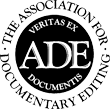Essays
Editors' Introduction to the 2013 Issue of Scholarly Editing: The Annual of the Association for Documentary Editing
The second issue of Scholarly Editing: The Annual of the Association for Documentary Editing offers three editions that are remarkable in their scope. The texts range from fifteenth-century London to twentieth-century Omaha and are edited by scholars from Belgium, Switzerland, the United Kingdom, and the United States. They also implement a variety of editorial methodologies that evidence the rigor and interpretive significance of scholarly editing.
Alpo Honkapohja has edited "The Trinity Seven Planets," a study of a fifteenth-century Middle English astrological treatise that was part of a larger set of texts bound as a portable physician's reference. The book, which mixes Latin and Middle English materials, suggests that before the printing press arrived in England, there was a commercial trade in medical books in London or its suburbs. In his introduction, Honkapohja offers a close paleographical study of the document and carefully explains his editorial methodology, which seeks to maximize flexibility so that the edition retains all the features necessary to make it useful to historical linguistics while also being richly encoded in order to be of use to more general readers. For instance, because the text is part of a book meant to be compact and portable, it includes many abbreviations that would confound modern readers, but Honkapohja offers expansions, as well as numerous glosses, that make the text more readable while losing none of the original content. The edition also offers beautiful full-color scans of the material, and helpful illustrations of the text's bibliographic relationship to other manuscripts.
Elizabeth Lorang and Rebecca Weir offer an edition that focuses on the importance of newspapers in antebellum American literature, and through close textual scholarship they uncover fascinating connections between the abolitionist press and the African American press. They have selected an astonishing 138 poems published in the National Anti-Slavery Standard and the Anglo-African, which help illustrate not only how these historically important newspapers employed poetry during the Civil War but also the ways in which they were connected to each other. The edition is itself a revelatory project, and includes careful and thorough annotations that help contextualize the materials. But it also serves as a model for the kind of foundational textual scholarship that remains to be done on periodicals, as such editions have been generally neglected in print editorial work. The editors are guided by an interest in how the poems' periodical context affects how they were read, and so they present scans of the entire issue of the newspaper in which the poems appeared.
Marianne Van Remoortel is also interested in newspaper poetry, and presents a study of how Dante Gabriel Rossetti's "Sunset Wings" was circulated in American periodicals. Her edition is a model for how editors can use materials from mass digitization projects to create carefully edited small-scale editions, as well as use tools developed for digital humanities projects. She finds her materials using databases of digitized periodicals, but then repurposes them in a more careful scholarly edition. She tracks how newspapers across the United States reprinted the poem for decades, beginning with reprints that were produced before Rossetti was widely known, as evidenced by their frequent misspellings of his name, and continuing into the twentieth century. She offers different ways of accessing these reprints, including through a dynamic geographical representation of these newspapers by using Neatline, a tool developed by Scholars' Lab at the University of Virginia Library that allows users to track geographical data onto historical maps. Readers can also study textual differences among the reprints individually or through Juxta, a text comparison tool developed by Networked Interface for Nineteenth-century Electronic Scholarship (NINES).
While these editions span an array of materials and approaches, we noticed that they all have something in common: they each consider the material production of the texts as centrally important to their meaning. Honkapohja's "Trinity Seven Planets" considers the book as evidence of a pre-Gutenberg book trade; Lorang and Weir's "Poems of the Anglo-African and National Anti-Slavery Standard, 1863-1864" establishes bedrock information about the material production of abolitionist texts in New York; and Van Remoortel's "A Poem's Flight" views the first transatlantic reprint as a starting point for tracking a poem's post-authorial afterlife. The result, in each case, is an edition that evidences the strength and flexibility of the digital environment for enriching the way we read texts.
This issue of Scholarly Editing also offers essays by a range of scholars: Dot Porter's "Medievalists and the Scholarly Digital Edition" studies the development of medieval digital editions since 2002, offering intriguing factual evidence about how and by whom they are used. Jane Calvert's "The 'Documentary Democracy' of the Writings of John Dickinson, Then and Now" discusses her efforts to edit the works of an important founder of the United States in a way that will make them more fully accessible to a wide readership, arguing that digital editing be considered a form of democratization. Finally, we offer Carol DeBoer-Langworthy's address as the outgoing president of the Association for Documentary Editing, presented at the annual meeting in 2012, in which she reflects on the role and significance of the documentary editor over her years of familiarity with the field.
All this material, in combination with two reviews of new editions and the journal's annual list of "Recent Editions," reflects the vibrant and varied world of editorial scholarship in both print and digital environments.
 PDF
PDF
